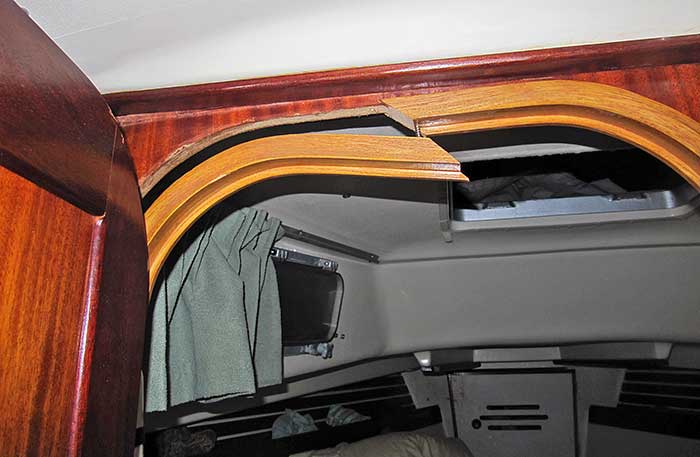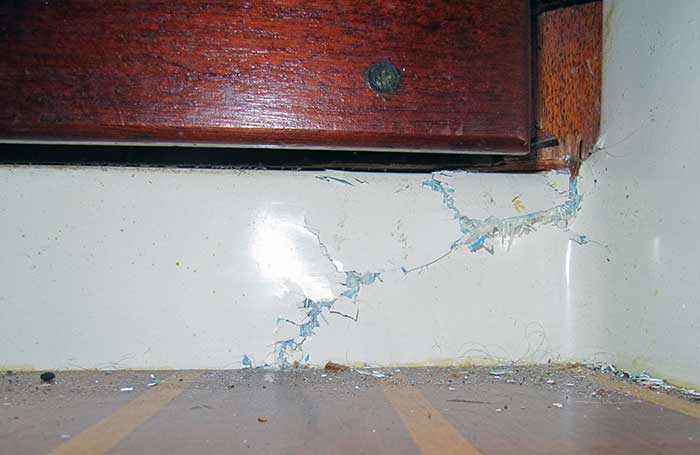Advertisement
The unlikely odds of an improbable encounter with a whale leave these two sailors with valuable cruising lessons on being prepared — and, unfortunately, with a broken boat.
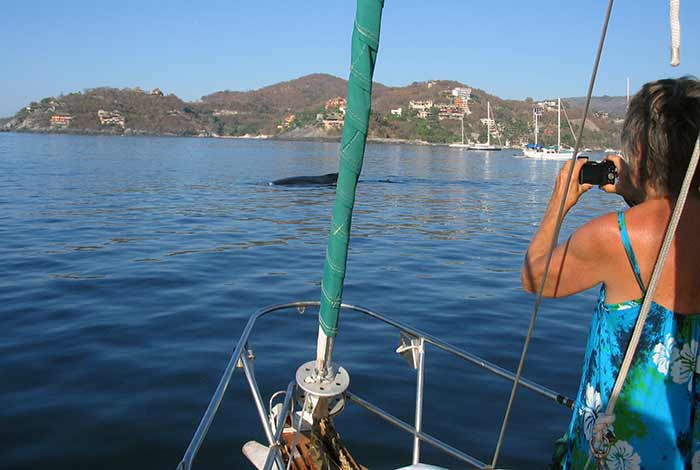
Humpback whales visit the Pacific Ocean side of Mexico from mid-October until late March.
In December 2010, we flew down to Mazatlan in Mexico from Idaho to sail our Pearson 367, Luffin It, planning on a quiet few months of sailing down the Pacific Coast of Mexico to Zihuatanejo. We had purchased Luffin It the year before and this was our third cruise. After several pleasant months sailing to Zihuatanejo, we started north toward Puerto Vallarta, which we figured would take us 10 to 12 days, taking our time and dropping anchor along the way.
March 2nd began uneventfully. Around 11 a.m., with the sun shining, the winds light, and the air a pleasant temperature, we raised anchor and sailed out of Barra Navidad toward one of our favorite anchorages, Tenacatita. We saw only dolphins and manta rays en route, and in the afternoon around 3:30 p.m., we turned off the motor and were sailing at 3-4 knots, as we turned into Tenacatita Bay.
Then suddenly, BOOM! We felt a violent heaving of the boat and then the stern dramatically being lifted out of the water. Darryl yelled that we had run aground. But as we jolted back and forth, I saw the flipper and dorsal fin of a large humpback whale off our stern and starboard side. After the initial impact, our boat was thrown over to starboard at a 40- to 50-degree angle. The sound of the whipping of his tail as the whale tried to free himself from the boat seemed to last forever. We hung on to anything and everything, just to stay in the boat, and felt an intense pounding on the cockpit sole for several, seemingly neverending seconds, as we were thrust back and forth. And then, silence, as the whale swam away, seemingly unhurt. As best we could determine, his flukes had gotten trapped between the back of our keel and the rudder skeg, and the thrashing was his attempt to free himself.
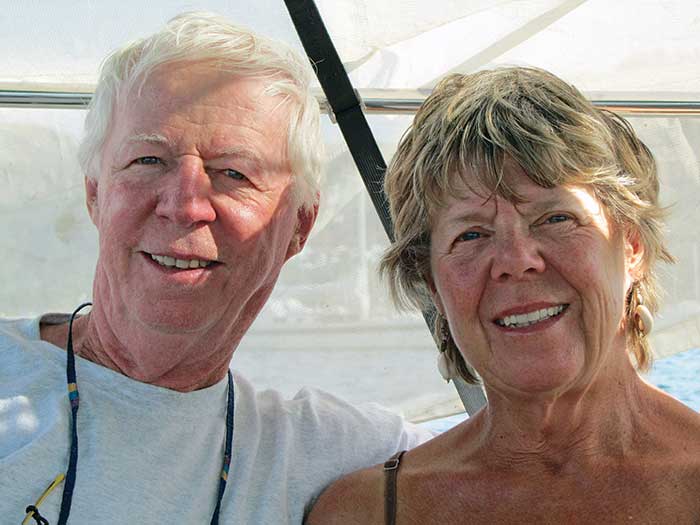
Darryl and Donna aboard.
We quickly looked under the main cabin sole and discovered water rushing in. We grabbed our life jackets and Darryl called a mayday over our VHF. The electric bilge pump was running, but not stemming the inflow. I grabbed the manual bilge pump and started pumping. We started the motor, felt a severe vibration in forward gear, and started preparing items to take if we had to abandon ship. Luckily for us, three dinghies from several boats in the anchorage just one-and-a-half miles away came zipping out within 10 minutes. They hooked up to us, came aboard with portable bilge pumps, and helped Darryl assess the damage while I steered the boat. Our friends on 40 Love brought their sailboat out in case we needed to abandon ship in a hurry.
We stabilized, and once we started the motor and put it in forward, the water leakage from the prop shaft seal slowed down significantly, letting us slowly motor into Tenacatita and drop anchor. Fellow cruisers continued to help; Bill from Fai Sin suited up in his wet suit and checked for damage under the boat — finding a bent strut and prop shaft, a broken lower rear section of the rudder, the exhaust pipe almost closed off, and the exit ladder bent. There also appeared to be scrapes — perhaps from the barnacles on the whale? — along the keel.
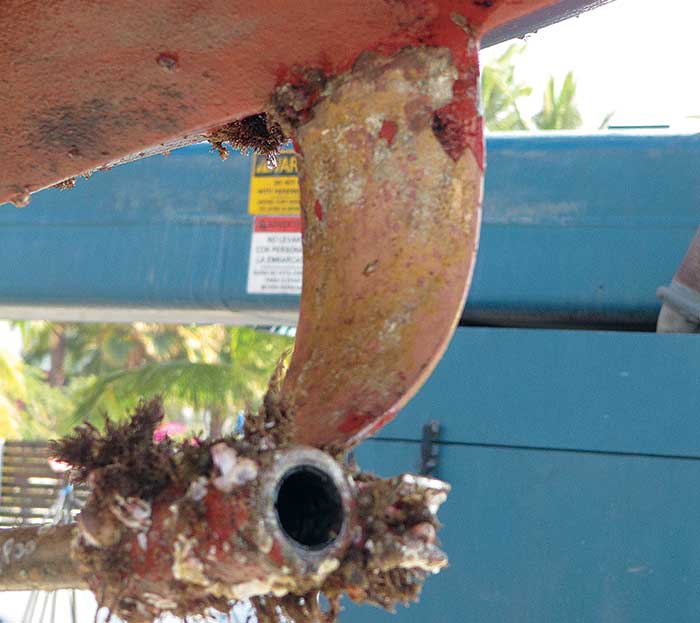
The damage to Donna and Darryl's boat, Luffin It, was extensive, after a pleasant sailing day took a dramatic turn.
Sleep was hard to come by that night. We lay in the main saloon so that we could listen for the bilge pump, woke up several times, had long conversations about our recollections, and made a plan to try to make it to the nearest boatyard at the La Cruz Marina in Banderas Bay more than 130 miles away. We packed important documents and items to remove in case we still needed to abandon the boat. For the rest of our trip, Darryl and I got little sleep.
The next morning, we took off under sail with the motor running at low rpm to reduce the banging and thumping, grateful that our friends on 40 Love had offered to buddy-boat with us on our slow limping journey to the boatyard. We dropped anchor in Chamela, leaving in the morning to sail all night around Cabo Corrientes to La Cruz. At 3:30 a.m., we heard a loud thumping noise coming from our prop shaft and discovered our leak flow had increased. Thankfully, the bilge pump seemed to be managing it. We put the motor in neutral, as we didn't feel we could go forward without further damage to the hull. That turned out to be a prudent decision; at haul-out several days later, the inspection showed a paper-thin stern tube and no propeller. With little wind, and no motoring power, we drifted along until daylight. Around 7 a.m., Darryl, and Joel from 40 Love, set up a 250-foot towline so we could continue our journey to La Cruz. By around 9:00 a.m., we rounded Cabo Corrientes with approximately 30 miles to go to reach La Cruz. It took close to 10 hours to cover the last 30 miles.
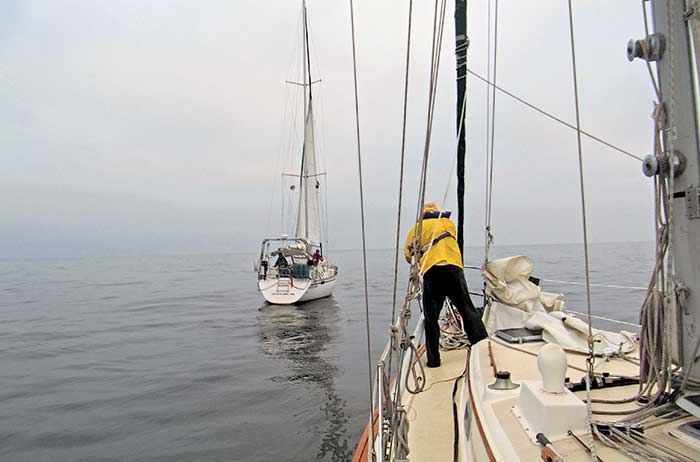
When we finally arrived in La Cruz around 7 p.m. that evening, a panga with three men pulled us safely to a dock near the haul-out station. Relieved to have made it without any further mishaps (winds the following day were 20-plus knots and could have spelled serious trouble for us, given our boat's condition), we cleaned the boat, pulled off personal items, and got ready for a haul-out. Four days later, the survey was completed. Luffin It had done her job in staying afloat and keeping us out of the water, but she'd sustained considerable damage and was declared a total loss by the surveyor.
Now, a year-and-a-half later, we still talk about our encounter and feel so grateful that no one fell over the side, and that nothing else compounded this calamity. We know this was a chance encounter; the whale wasn't trying to hurt us, and after haulout, it was clear the whale was breaching and didn't see us. The whales along the Pacific Coast are magnificent mammals and have made our sailing trips memorable with their grace, power, and beauty.
How To Plan For The Unexpected
- In preparation for cruising, we had both read an article on a boat that was struck by a whale and went down in less than 45 minutes. We then sat down and mapped out a plan of what we'd do in the event of an emergency. I believe that helped us to react swiftly.
- Anything can happen, at any time, even a mile-and-a-half from anchorage. When sailing at night or in rough weather, or with any unexpected emergency, put your life jacket on without delay.
- All crew should know how to work the manual bilge pump. We had just pulled both out and gone through the dirty job of cleaning the filters, installing a high-water alarm, and testing the system a week before.
- Make sure your VHF/SSB radios work. Without these, our encounter could have been dire. Your VHF should be DSC-enabled and hooked up to your GPS so that, should you need to set off a mayday, rescuers will continue to automatically get your latitude and longitude. This is a simple connection available on newer VHF models.
- Carry a GPIRB (GPS-enabled EPIRB). It's easy and inexpensive to rent one from the BoatUS Foundation.
- Attempt to contain/slow down any water entering your boat. At the time of the encounter, our automatic bilge pump kicked on. But before even knowing that, Donna started pumping the manual bilge.
- Organize communications. Assign one person at a time on the boat to monitor Channels 16 and 22, and communicate on a third specific channel for discussing and monitoring the situation. This person should keep clear notes of any cruisers calling in, help offered, and people to call back later.

